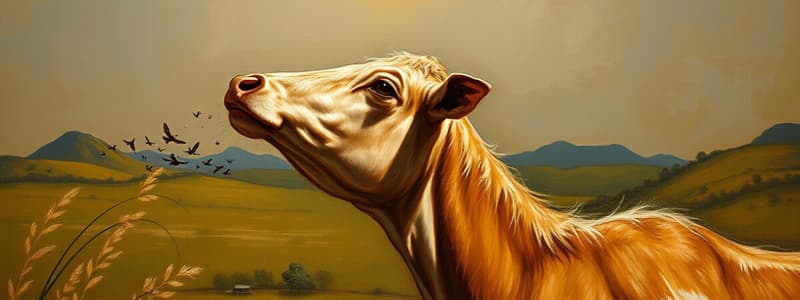Podcast
Questions and Answers
What is the estimated annual cost of flystrike to Australian sheep industry?
What is the estimated annual cost of flystrike to Australian sheep industry?
$280 million
Name the two most prevalent types of flystrike.
Name the two most prevalent types of flystrike.
Body strike and breech strike
What species of blowfly is responsible for initiating around 90% of flystrikes?
What species of blowfly is responsible for initiating around 90% of flystrikes?
Lucilia cuprina
What is the appearance and size of the adult Australian sheep blowfly?
What is the appearance and size of the adult Australian sheep blowfly?
How does environmental condition affect the risk of flystrike?
How does environmental condition affect the risk of flystrike?
What role does the hairy maggot fly, Chrysomya rufifacies, play in flystrike?
What role does the hairy maggot fly, Chrysomya rufifacies, play in flystrike?
Why is reducing the risk of flystrike important for sheep farming?
Why is reducing the risk of flystrike important for sheep farming?
What is produced by the Australian sheep blowfly as part of its life cycle?
What is produced by the Australian sheep blowfly as part of its life cycle?
What is a significant consequence of flystrike on sheep?
What is a significant consequence of flystrike on sheep?
What factors contribute to the susceptibility of sheep to flystrike?
What factors contribute to the susceptibility of sheep to flystrike?
What is the typical lifespan of adult flies?
What is the typical lifespan of adult flies?
How long does it typically take for eggs to hatch into larvae?
How long does it typically take for eggs to hatch into larvae?
What temperature range is ideal for the activity of L.cuprina?
What temperature range is ideal for the activity of L.cuprina?
What factors contribute to the perfect environmental conditions for flystrike?
What factors contribute to the perfect environmental conditions for flystrike?
What are some common protein sources needed by female flies before laying eggs?
What are some common protein sources needed by female flies before laying eggs?
How does wind speed affect L.cuprina activity?
How does wind speed affect L.cuprina activity?
What is the best-case scenario for sheep susceptibility to flystrike?
What is the best-case scenario for sheep susceptibility to flystrike?
Why is the incidence of strikes significant even with low numbers of L.cuprina flies?
Why is the incidence of strikes significant even with low numbers of L.cuprina flies?
What is one long-term strategy to reduce flystrike risk?
What is one long-term strategy to reduce flystrike risk?
How often should paddock monitoring be undertaken during high-risk times?
How often should paddock monitoring be undertaken during high-risk times?
Flashcards are hidden until you start studying
Study Notes
Overview of Flystrike
- Flystrike is a major health risk for Australian sheep, costing approximately $280 million annually.
- Active monitoring and management are essential to prevent productivity losses and ensure animal welfare.
Impact on Profitability
- Flystrike affects profitability through lost productivity in struck animals and increased treatment costs.
- Managing flystrike enhances the health and wellbeing of sheep and boosts farm productivity.
Types of Flystrike
- Five flystrike types exist, with body and breech strikes being the most prevalent.
- Risk levels depend on environmental conditions and sheep susceptibility.
Predicting Flystrike Risk
- Risk prediction hinges on environmental factors and sheep vulnerability.
- Understanding the biology of the Australian blowfly (Lucilia cuprina) aids in forecasting flystrike occurrences.
Biology of the Australian Blowfly
- Australian sheep blowfly is the main species, responsible for 90% of strikes; it measures around 10 mm, with a copper green color and reddish eyes.
- Its life cycle includes:
- Eggs hatching into larvae within 12-24 hours.
- Larvae grow from pinhead size to 10-15 mm in about three days.
- Adult flies live for 2-3 weeks, with a life cycle to maturity taking 17 days in warm weather.
Environmental Conditions for Flystrike
- Ideal conditions for flystrike include:
- Presence of the Australian sheep blowfly.
- Temperatures between 15-38 degrees Celsius.
- Recent rain to maintain suitable moisture levels for about three days.
- Suitable sites on sheep (wrinkles, urine, feces) for attracting flies.
- Wind speeds below 9 km/h to facilitate fly movement.
Susceptibility of Sheep
- Susceptibility is influenced by environmental factors, sheep type, and management strategies.
- Best-case scenarios include:
- Plain-bodied sheep with low fleece rot incidence.
- Well-managed hoggets with good worm control.
- Lambs with low breech wrinkle levels.
- Regular paddock monitoring and effective flystrike treatment.
- Worst-case scenarios involve:
- Highly wrinkled Merino sheep with poor maintenance.
- Long, unshorn wool during peak risk periods.
Strategies to Reduce Flystrike Risk
- Long-term genetic options serve as effective measures to lower risk.
- Various short-term husbandry practices can be implemented to enhance flystrike prevention.
Studying That Suits You
Use AI to generate personalized quizzes and flashcards to suit your learning preferences.




